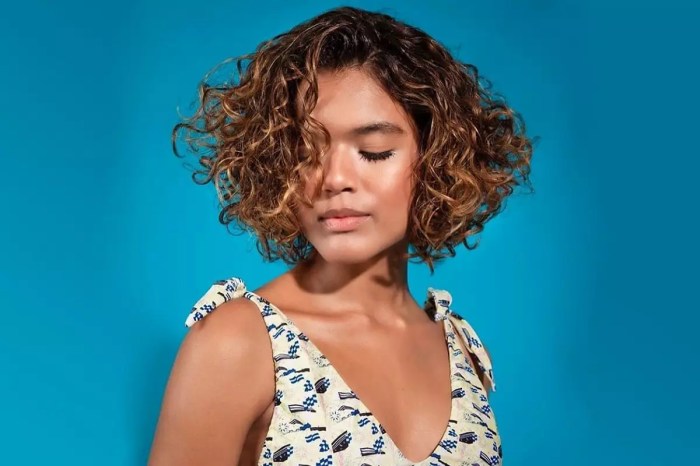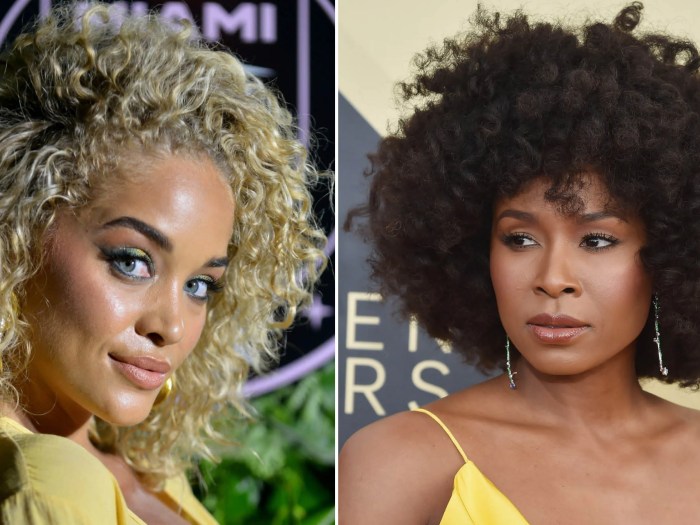Hairstyle Curly Hair A Comprehensive Guide
Understanding and Styling Curly Hair
Hairstyle curly hair – Curly hair, a captivating and diverse hair type, requires a specialized approach to care and styling. Understanding its unique characteristics is key to achieving healthy, vibrant curls. This guide delves into the intricacies of curly hair, covering various types, popular hairstyles, effective care routines, styling techniques, and common problem-solving strategies.
Curly Hair Types
Curly hair is categorized using the Andre Walker Hair Typing System, which classifies curls based on pattern, density, and porosity. This system helps individuals understand their hair’s specific needs and choose appropriate products and styling methods.
- Type 2 (Wavy): Characterized by loose, S-shaped waves. 2A has fine, loose waves; 2B has more defined waves; and 2C has tighter, almost curly waves. Density and porosity vary.
- Type 3 (Curly): Defined by distinct ringlets and spirals. 3A curls are loose and bouncy; 3B curls are tighter and springier; and 3C curls are tight, corkscrew-like curls. Porosity and density can differ significantly.
- Type 4 (Coily): Features tightly coiled, Z-shaped curls. 4A coils are tightly packed; 4B coils are more densely packed and often form zig-zag patterns; and 4C coils are extremely tightly packed, often appearing as a dense mass. High porosity is common.
Hair porosity refers to the hair shaft’s ability to absorb and retain moisture. High porosity hair absorbs moisture quickly but loses it just as fast, requiring moisturizing products. Low porosity hair struggles to absorb moisture, needing products that help open the cuticle. Understanding porosity is crucial for effective product selection.
Popular Curly Hairstyles

Source: lovehairstyles.com
Numerous hairstyles flatter various curl types and face shapes. Choosing a style depends on hair length, curl pattern, and personal preference.
| Hairstyle Name | Hair Type | Description | Image Description |
|---|---|---|---|
| Short Curly Pixie | 2C – 3A | A short, choppy cut that accentuates the curls’ texture and volume. Ideal for those with fine to medium density hair. | A close-cropped pixie cut with short, bouncy curls framing the face, showcasing a vibrant, textured look. The style is slightly layered to enhance volume and movement. |
| Medium-Length Curly Bob | 3B – 3C | A classic bob cut with defined, springy curls. Can be styled straight across or with layers for added texture. | A shoulder-length bob with well-defined, tight ringlets. The cut is blunt, creating a sleek and polished look. The curls are evenly distributed, creating a full and bouncy appearance. |
| Long Curly Layers | 3C – 4A | Long hair styled with layered cuts to reduce weight and enhance curl definition. Layers create movement and prevent the hair from looking too heavy. | Long hair styled in cascading layers, with each layer showcasing well-defined, spiraling curls. The layers create movement and volume, avoiding a heavy or flat appearance. The overall effect is one of effortless, textured beauty. |
Visual Representation of Hairstyles and Face Shapes: Imagine a series of images showcasing different curly hairstyles on various face shapes. For example, a long, layered style would flatter an oval face by adding volume and length, while a short, curly pixie would highlight the features of a round face by drawing attention upwards. A medium-length curly bob would complement a square face by softening the angles.
Curly Hair Care Routines
A consistent curly hair care routine is vital for maintaining healthy, hydrated curls. This routine should prioritize gentle cleansing, deep conditioning, and regular moisturizing.
- Wash: Use a sulfate-free, moisturizing shampoo to cleanse the scalp and hair without stripping natural oils.
- Condition: Apply a generous amount of conditioner, focusing on the ends. Leave it in for several minutes before rinsing thoroughly.
- Deep Condition: Once or twice a week, use a deep conditioner to intensely hydrate and nourish the hair.
- Detangle: Gently detangle hair using a wide-tooth comb or your fingers, starting from the ends and working upwards. Avoid aggressive brushing, which can cause breakage.
- Moisturize: Apply a leave-in conditioner or curl cream to add moisture and definition.
- Style: Use techniques like finger coiling, diffusing, or air drying to style your curls.
Sulfate-free shampoos are gentler on curly hair, preserving its natural oils and preventing dryness. Moisturizing products are essential for hydration and curl definition, combatting frizz and dryness.
Styling Curly Hair
Various techniques can be employed to enhance curl definition and manage frizz. Product selection plays a crucial role in achieving desired results.
- Finger Coiling: Gently wrapping individual strands around your finger to define each curl.
- Diffusing: Using a diffuser attachment on a hairdryer to dry hair gently while enhancing curl definition and volume.
- Styling Products: Curl creams, gels, mousses, and oils can help define curls, add moisture, and control frizz.
Examples of styling products include curl creams for moisture and definition, gels for hold and shine, mousses for volume, and oils for added hydration and shine. Heat styling tools should be used sparingly, as excessive heat can damage curly hair.
Addressing Common Curly Hair Problems, Hairstyle curly hair

Source: allure.com
Curly hair is prone to certain issues, including dryness, frizz, and breakage. Understanding the causes and implementing effective solutions is crucial for maintaining healthy curls.
- Frizz: Often caused by dryness and humidity. Solutions include using moisturizing products, minimizing manipulation, and using anti-frizz serums.
- Dryness: Can result from insufficient moisture and harsh products. Solutions include deep conditioning, using moisturizing products, and limiting heat styling.
- Breakage: Can occur due to dryness, harsh manipulation, and heat damage. Solutions include gentle detangling, minimizing manipulation, and using protective styles.
Tips for maintaining healthy curly hair include minimizing heat styling, using gentle detangling techniques, and protecting hair from environmental stressors.
Curly Hair and Different Ethnicities
Curly hair varies significantly across different ethnic groups, reflecting genetic diversity and cultural practices. Understanding these variations is key to providing tailored care.
- African Hair: Often characterized by tightly coiled, kinky hair, requiring specific moisturizing and detangling techniques.
- Hispanic Hair: Can range from wavy to tightly coiled, with varying porosity and density, requiring personalized care based on individual hair type.
- Asian Hair: While less commonly associated with extremely curly hair, some individuals may have wavy or loosely curled hair, requiring gentler styling and moisturizing practices.
Traditional styling methods vary across cultures. For instance, protective styles like braids and twists are commonly used in many African cultures to protect hair and minimize manipulation. Different cultural groups also employ unique ingredients and techniques for moisturizing and conditioning.
The Role of Diet and Health in Curly Hair
A balanced diet and overall health significantly impact hair growth and condition. Nutrients play a crucial role in promoting healthy, strong hair.
- Foods promoting hair growth: Foods rich in protein, iron, zinc, biotin, and vitamins A, C, and E.
Conditions like hormonal imbalances, autoimmune diseases, and nutritional deficiencies can negatively affect hair health and appearance. Addressing underlying health issues is crucial for improving hair condition.
Detailed FAQs: Hairstyle Curly Hair
What is the best way to detangle curly hair?
Always detangle curly hair when it’s wet and conditioned to minimize breakage. Use a wide-tooth comb or your fingers, starting from the ends and working your way up.
How often should I wash my curly hair?
Washing frequency depends on your hair type and scalp, but generally, washing 1-2 times a week is sufficient for most curly hair types to avoid stripping natural oils.
How can I reduce frizz in my curly hair?
Styling curly hair can be a fun challenge, offering a wide variety of looks. If you’re considering a shorter style, a great starting point is to explore options for similar hair textures, such as checking out the many stylish ideas for short hairstyles for wavy hair , which often provide inspiration adaptable to curly cuts. Ultimately, the best hairstyle will depend on your individual face shape and personal preference.
Minimize frizz by using a moisturizing conditioner, applying a leave-in conditioner or curl cream, and avoiding harsh towel drying. Consider using a satin bonnet or pillowcase at night.
What are some good foods for healthy hair growth?
Foods rich in protein, iron, and vitamins like biotin and vitamin D are beneficial for hair health. Examples include eggs, leafy greens, nuts, and fatty fish.












